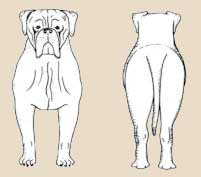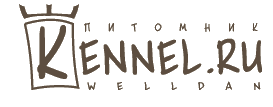Cranial region
In the male: the perimeter of the skull measured at the level of its greatest width corresponds roughly to the height at the withers.
In bitches: it may be slightly less. Its volume and shape are the consequences of the very important development of the temporals, supra-orbital arches, zygomatic arches and the spacing of the branches of the lower jaw.
The upper region of the skull is slightly convex from one side to the other. Fronto-nasal depression or stop is very pronounced, almost forming a right angle with the muzzle (95° to 100°). The frontal groove is deep, diminishing towards the posterior end of the head. The forehead dominates the face. However it is still wider than high. The head is furrowed with symmetrical wrinkles, each side of the median groove. These deep ropes of wrinkle are mobile depending on whether the dog is attentive or not.
Facial region:
Nose: Broad, well opened nostrils, well pigmented according to the mask. Upturned nose (snubbed) permissible but not if it is set back towards the face.
Muzzle: Powerful, broad, thick, but not fleshy below the eyes, rather short, upper profile very slightly concave, with moderately obvious folds. Its width hardly decreasing towards the tip of the muzzle, when viewed from above it has the general shape of a square. In relation to the upper region of the skull, the line of the muzzle forms a very obtuse angle upwards. When the head is held horizontally the tip of the muzzle, truncated, thick and broad at the base, is in front of a vertical tangent to the anterior face of the nose. Its perimeter is almost two thirds of that of the head. Its length varies between one third and one quarter of the total length of the head, from the nose to the occipital crest. The limits stated (maximum one third and minimum one quarter of the total length of the head) are permissible but not sought after, the ideal length of the muzzle being between these two extremes.
Jaws: Very powerful, broad. Undershot (the undershot condition being a characteristic of the breed). The back of the lower incisors is in front of and not in contact with the front face of the upper incisors. The lower jaw curves upwards. The chin is well marked and must neither overlap the upper lip exaggeratedly nor be covered by it.
Teeth: Strong, particularly the canines. Lower canines set wide apart and slightly curved. Incisors well aligned especially in the lower jaw where they form an apparently straight line.
Upper lip: Thick, moderately pendulous, retractile. When viewed in profile it shows a rounded lower line. It covers the lower jaw on the sides. In front the edge of the upper lip is in contact with the lower lip, then drops on either side thus forming a reversed wide V.
Cheeks: Prominent, due to the very strong development of the muscles.
Eyes: Oval, set wide apart. The space between the two inner angles of the eyelids is equal to about twice the length of the eye (eye opening). Frank expression. The haw must not be visible. Colour : hazel to dark brown for a dog with a black mask, lighter colour tolerated but not sought after in dogs with either a brown mask or without a mask.
Ears: Relatively small, of a slightly darker colour than the coat. At its set on the front of the base of the ear is slightly raised. They must fall back, but not hang limply, the front edge being close to the cheek when the dog is attentive. The tip of the ear is slightly rounded; it must not reach beyond the eye. Set rather high, at the level of the upper line of the skull, thus appearing to accentuate its width even more.
 Body
Neck:
Body
Neck: Very strong, muscular, almost cylindrical. The skin is supple, ample and loose. The average circumference almost equals that of the head. It is separated from the head by a slightly accentuated transversal furrow, slightly curved. Its upper edge is slightly convex. The well defined dewlap starts at the level of the throat forming folds down to the chest, without hanging exaggeratedly. The neck, very broad at its base, merges smoothly with the shoulders.
Topline: Solid with a broad and muscular back, withers well marked, broad loin, rather short and solid, rump moderately sloping down to the root of the tail.
Croup: Moderately sloping down to the root of the tail.
Chest: Powerful, long, deep, broad, let down lower than the elbows. Broad and powerful breast whose lower line (inter-axillae) is convex towards the bottom. Ribs well let down and well sprung but not barrel shaped. The circumference of the chest must be between 0,25 to 0,30 m greater than the height at the withers.
Underline: Curved, from the deep brisket to the rather tucked up, firm abdomen, being neither pendulous nor whippety.
Tail: Very thick at the base. Its tip preferably reaching the hock and not below. Carried low, it is neither broken nor kinked but supple. Hanging when the dog is in repose, generally rising by 90° to 120° from that position when the dog is in action, without curving over the back or being curled.
